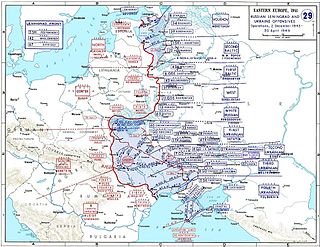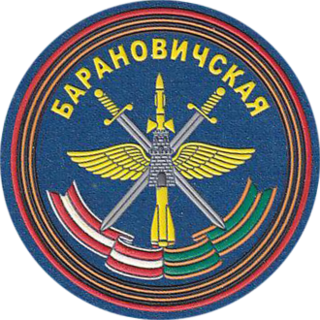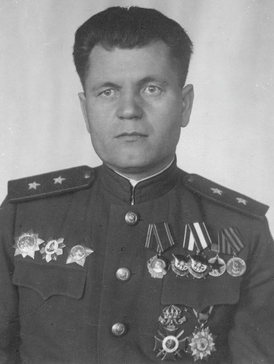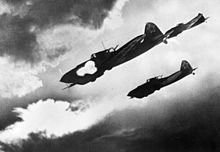The 270th Rifle Division was a Red Army infantry division formed twice during World War II, in 1941 and 1942.

The Dnieper–Carpathian offensive, also known in Soviet historical sources as the Liberation of Right-bank Ukraine, was a strategic offensive executed by the Soviet 1st, 2nd, 3rd, and 4th Ukrainian Fronts, along with the 2nd Belorussian Front, against the German Army Group South, Army Group A and elements of Army Group Center, and fought from late December 1943 to early May 1944. The battles in right-bank Ukraine and in the Crimea were the most important event of the 1944 winter-spring campaign on the Eastern Front.
An Aviation Division was a type of formation of the Military Air Forces of the Red Army during the Second World War, the Soviet Air Forces, Soviet Air Defence Forces (PVO) and Aviation of the Military Naval Fleet, and since 1991 remain major formations within the Military Air Forces of the Russian Federation.

Mikhail Konstantinovich Puteiko was a Belarusian Red Army major general killed in action during World War II.

The 1st Guards Stalingrad Composite Aviation Division is an Aviation Division of the Russian Aerospace Forces. It was originally formed as the 226th Assault Aviation Division in May 1942 and became the 1st Guards Stalingrad Assault Aviation Division for its performance in the Battle of Stalingrad. The division fought in the Melitopol Offensive, Crimean Offensive, East Prussian Offensive and the Battle of Königsberg. By the end of the war, the division had been awarded the Order of the Red Banner twice, the Order of Lenin and the Orders of Kutuzov and Suvorov 2nd class. Postwar, the division relocated to Belarus. In April 1956, it became a bomber division but was converted to a fighter-bomber unit in 1957. In 1989, it became an bomber unit again and moved to Krasnodar in 1993. At Krasnodar it became an assault unit. The division moved to Yeysk in 2002 and disbanded in 2009. It was reformed in 2013 with the addition of extra fighter units.

The 4th Guards Airborne Division was an airborne division of the Red Army that fought as infantry during World War II.
The 269th Rifle Division was an infantry division of the Soviet Union's Red Army during World War II.
The 5th Air Army was an air army of the Soviet Air Forces and later the Ukrainian Air Force. First formed in 1942 during World War II, the army provided air support to Soviet forces through the rest of the war, and was renumbered as the 48th Air Army in 1949. It was stationed in the Odessa Military District during the postwar period, and in 1968 its original number was restored. Between 1980 and 1988 it was known as the Air Forces of the Odessa Military District. Redesignated as the 5th Air Army again in 1988, it became part of the Ukrainian Air Force after the dissolution of the Soviet Union, and was converted into an aviation corps in 1994.
The 7th Guards Tank Division was a tank division of the Soviet Army during the Cold War.
The 263rd Rifle Division was an infantry division of the Red Army during World War II.
The 5th Guards Anti-Aircraft Artillery Division was an anti-aircraft artillery division of the Soviet Union's Red Army during World War II.

Vasily Minayevich Shugayev was a Soviet Army major general and a Hero of the Soviet Union.
The 58th Guards Rifle Division was an elite Guards infantry division of the Red Army during World War II.
The 36th Guards Rifle Division was a Guards infantry division of the Red Army during World War II. It was formed from the 9th Airborne Corps in August 1942 as a result of the Soviet need for troops to fight in the Battle of Stalingrad. The division was awarded the honorific Verkhnedneprovsk for its crossing of the Dnieper in September 1943 near that town, later receiving the Order of the Red Banner and the Order of Suvorov, 2nd class, for its actions in the Uman–Botoșani Offensive in March 1944. It fought in the siege of Budapest during late 1944 and early 1945, receiving the Order of Kutuzov, 2nd class, for its actions. In late 1945, it was converted into the 24th Guards Mechanized Division. Stationed in Romania, it was disbanded in early 1947.
The 84th Rifle Division was an infantry division of the Red Army before and during World War II.
The 121st Rifle Division was an infantry division of the Red Army during World War II.

Dmitry Petrovich Monakhov was a Red Army major general who held division and corps command before being killed in World War II.

Pavel Grigoryevich Kuznetsov was a Soviet Army lieutenant general who held divisional and corps command during World War II.

Aleksey Mitrofanovich Vlasenko was a Soviet Army major general who held divisional commands during World War II.
The 257th Rifle Division was an infantry division of the Red Army, the third unit to bear the designation during World War II.








